Loading of Metals from Abandoned Mines in the Lefthand Creek Watershed
Overview
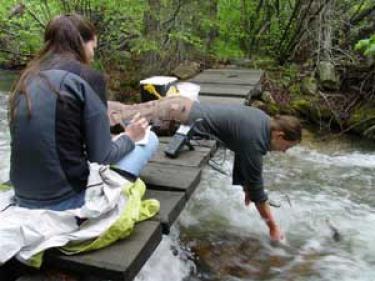
Roshan Cholas (REU, Summer, 2003) and Alice Wood (M.A., 2004) sample Lefthand Creek near Rowena in July 2003.
With initial funding from the University of Colorado's Outreach Committee, we are have been assisting the Lefthand Watershed Oversight Group (LWOG) in assessing the amount of location of metal inputs to the streams of the Lefthand Creek watershed. The watershed is located in northwestern Boulder County, near the towns of Ward and Jamestown in the area of the historic Jamestown Mining District.
The residents of Ward and Jamestown essentially live on the waste rock and mill tailings of the abandoned mines, which include the Big Five Tunnel and Captain Jack Mill (now a Superfund site being cleaned up by the state) and Slide mines along Lefthand Creek, the Golden Age, Fair Day, and John Jay Mines along James Creek, and the Bueno, Burlington, Emmit, Argo, and Evening Star Mines along Little James Creek.
The Left Hand Watershed Task Force, sponsored by Boulder County, put considerable effort into summarizing current knowledge of mine waste impacts in the Left Hand Watershed in its 2002 report, the Left Hand Watershed Task Force Final Report to the Boulder County Board of Health (the report is available in sections; here is a full report, a 4.4 MByte pdf file).
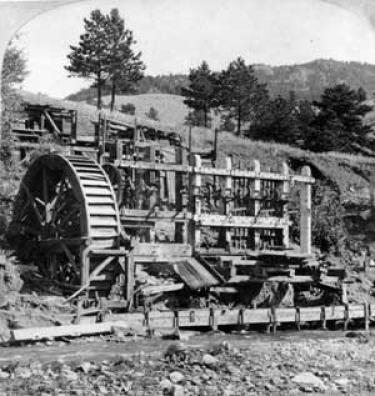
The Golden Age Mine mill in 1880 (from the Denver Public Library Western History Photography Collection).
Our research has focused on the sources of metals -- mainly copper, lead, and zinc -- in the watershed. To do this, we have conducted metal loading tracer tests pioneered by the U.S. Geological Survey for their Abandoned Mine Lands Initiative. For these tracer tests, a salt for which stream transport is essentially conservative (e.g., lithium chloride, sodium bromide) is steadily injected at an upstream injection point and its arrival at some downstream point is monitored by specific conductance. Dilution of the salt concentration along the stream is used to determine stream discharge. Once the stream contains a constantly-injected amount of the salt, a synoptic sampling is performed between the upstream injection point and the downstream monitoring point. The synoptic sampling is a "snapshot" (with the samples collected as quickly as possible) of the salt and metal concentration in the stream.
We have now performed these tests on over 50 km of streams in the Lefthand Creek watershed and produced a comprehensive report of the sources of metals. This report was used by LWOG to create the Lefthand Creek Watershed Plan. More reports will be issued in the near future on metals in waste rock piles, streambed sediments, and benthic macroinvertebrates in the watershed.As part of the Lefthand Watershed Revitalization team, Joe Ryan and Alice Wood, who completed her Master's thesis on metals in the Lefthand Creek watershed in 2004, and who served as the LWOG coordinator for its first two years, were honored with the EPA's National Notable Achievement Award for "Cross-Program Revitalization Team Award" in April 2006. The award recognized $8 million of collaborative remediation that will result in the cleanup of most of the significant sources of metals in the watershed.
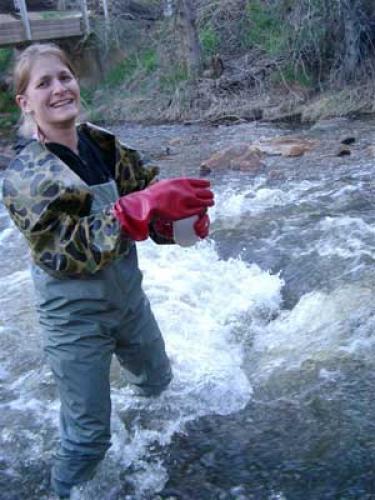
Susan Bautts (M.S., 2006) collects streambed sediment samples from James Creek in the town of Jamestown in October 2005.
Projects
- Relating Bioavailability of Metals to Metal Speciation and Colloid Nature and Abundance in Mountain Streams Contaminated by Acid Mine Drainage in Northwestern Boulder County, Colorado, University of Colorado Council on Research and Creative Work, 2004-2005, PI: Joe Ryan
- Contributing to the Remediation of Abandoned Mines in the Lefthand Creek Watershed (Northwestern Boulder County, Colorado) with the Lefthand Watershed Oversight Group, University of Colorado Outreach Committee, 2003-2005, PI: Joe Ryan
- Assessing the Risk of Mine Wastes in Jamestown, Colorado (Northwestern Boulder County), with the Citizens Advisory Group for the Environment and the James Creek Watershed Initiative, University of Colorado Outreach Committee, 2002, PI: Joe Ryan
University of Colorado Outreach Program Grant, 2002-2005 - Loading of Metals and Uranium to James Creek, Northwestern Boulder County, Colorado, from Surrounding Abandoned Mines
National Science Foundation Research Experience for Undergraduates, 2002-2004
Collaborators
- Left Hand Watershed Oversight Group
- Mark Williams, Water Quality Program Coordinator, Boulder County Department of Health
- Angus Campbell, Hazardous Materials and Waste Division, Colorado Department of Public Health and Environment
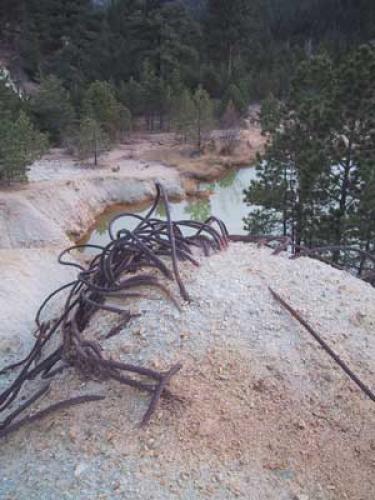
Steel cable near a mine shaft, with an acidic subsidence pit point in the background, at the Burlington Mine near the Little James Creek in 2002.
- Andrew Archuleta, U.S. Forest Service, U.S. Department of Agriculture
- Kathy Hernandez, U.S. Environmental Protection Agency, Region 8
Student Theses, Reports, and Presentations
- Susan M. Bautts, 2006, M.S., Civil and Environmental Engineering, University of Colorado at Boulder, An investigation of metal concentrations in waste rock piles, stream water, benthic macroinvertebrate tissues, and stream bed sediments to assess long-term impacts of intermittent precipitation events in the Lefthand Creek watershed, northwestern Boulder County, Colorado M.S. thesis.
- Drew Bryenton, 2004, B.S. Civil Engineering, Purdue University, 2005. National Science Foundation Research Experience for Undergraduates Final Presentation, Metals Content of Benthic Macroinvertebrates in Lefthand Creek Watershed.
- Roshan Cholas, 2003, B.S. Civil and Environmental Engineering, University of California at Berkeley, National Science Foundation Research Experience for Undergraduates Final Presentation, Acid Mine Drainage: Metals in Water and Sediment, Upper Lefthand Creek, Northwestern Boulder County, Colorado.
- Laura Harrington, 2002, B.S. Chemistry, Duke University, Durham, North Carolina, National Science Foundation Research Experience for Undergraduates Final Report, Impact of Mine Drainage and Distribution of Metal Loading Sources in the James Creek Watershed Assessed under Low-Flow Conditions, and Final Presentation, Impact of Mine Drainage and Distribution of Heavy Metal Contamination in the James Creek Watershed.
- Alice R. Wood, 2004, M.A., Environmental Studies, University of Colorado at Boulder, Characterization and Prioritization of Mining-Related Metal Sources with Metal Loading Tracer Dilution Tests, and a Review of Regulations and Mine Restoration Funding Resources, Lefthand Creek Watershed, Northwestern Boulder County, Colorado M.A. thesis.
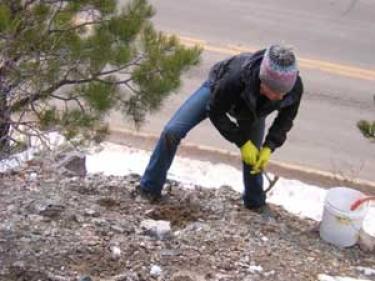
Amber Roche (Discovery Learning Apprentice) collects waste rock samples from a pile along Lefthand Creek near Lickskillet Road in March 2005.
Publications, Presentations, and News
- Engineering Professor and Student Selected for EPA Award, Inside CU, May 23, 2006.
- Concentrations of Metals in Waste Rock Piles, Benthic Macroinvertebrates, and Sediments as Monitors of Metal Contamination in the James and Little James Creeks, Boulder County, presented by Susan Bautts at a meeting of the James Creek Watershed Initiative, May 8, 2006.
- Effect of Burlington Mine Pond on Metal Concentrations in Little James Creek presented by Joe Ryan at a meeting of the Lefthand Watershed Oversight Group, December 6, 2005.
- Wood A.R., Cholas R., Harrington L., Isenhart L., Turner N., Ryan J.N., 2004. Characterization and Prioritization of Mining-Related Metal Sources in the Streams and Streambed Sediments of the Lefthand Creek Watershed, Northwestern Boulder County, Colorado, 2002-2003. Report 04-01, Department of Civil, Environmental, and Architectural Engineering, University of Colorado at Boulder, Boulder, Colorado, 139 pp.
- CU-Boulder Professor Assists in Remediation of Abandoned Mines, Inside CU, July 2004.
- Assessment of Zinc, Copper, and Lead in Streams and Streambed Sediments of the Lefthand Creek Watershed, Northwestern Boulder County, Colorado, presented by Alice Wood at the Water Environment Federation-American Water Works Association Student Conference, May 2004.
- Assessment of Metal Loads by Tracer Injection and Synoptic Sampling in the Lefthand Creek Watershed, Boulder County, Colorado, presented by Alice Wood at a meeting of the Lefthand Watershed Oversight Group, December 2003.
- Cleaning Up Abandoned Mines: Can and Will Communities Contribute?, presented by Joe Ryan at the Colorado Riparian Association's 16th Annual Conference, October, 2003.
- Cleaning Up Waters Polluted by Abandoned Mines: Obstacles and Opportunities, presented by Joe Ryan as part of the Reynolds Lecture Series, Colorado Chautauqua Association and the University of Colorado Chancellor's Office, July 2003.
- Profile: Engineer Examines Mine Waste In Streams. Boulder Daily Camera, April 6, 2003.
- Mining and Water Quality in the Western United States -- A Collision of Resources Part II. Abandoned Mines and Acid Mine Drainage in Boulder County, presented by Joe Ryan (with Kirk Nordstrom, U.S. Geological Survey) as part of the Boulder Creek Watershed Forum, April 2003.
- Abandoned Mines and Acid Mine Drainage: Dealing with the Hit-and-Run Legacy of Mining in the West, presented by Joe Ryan as part of the Center of the American West's Healing the West: Restoration, Remediation, Repair, and Mitigation series, March 5, 2003, Chautauqua Community House.
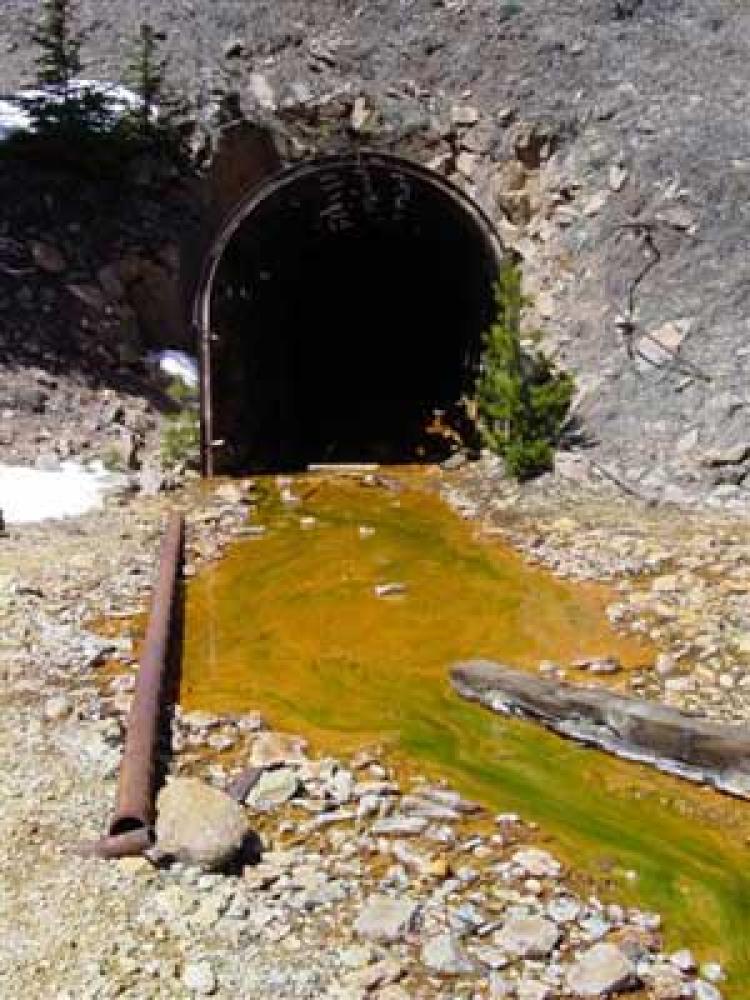
Acid mine drainage from the Big Five Tunnel on the Captain Jack Superfund site along Lefthand Creek south of Ward.
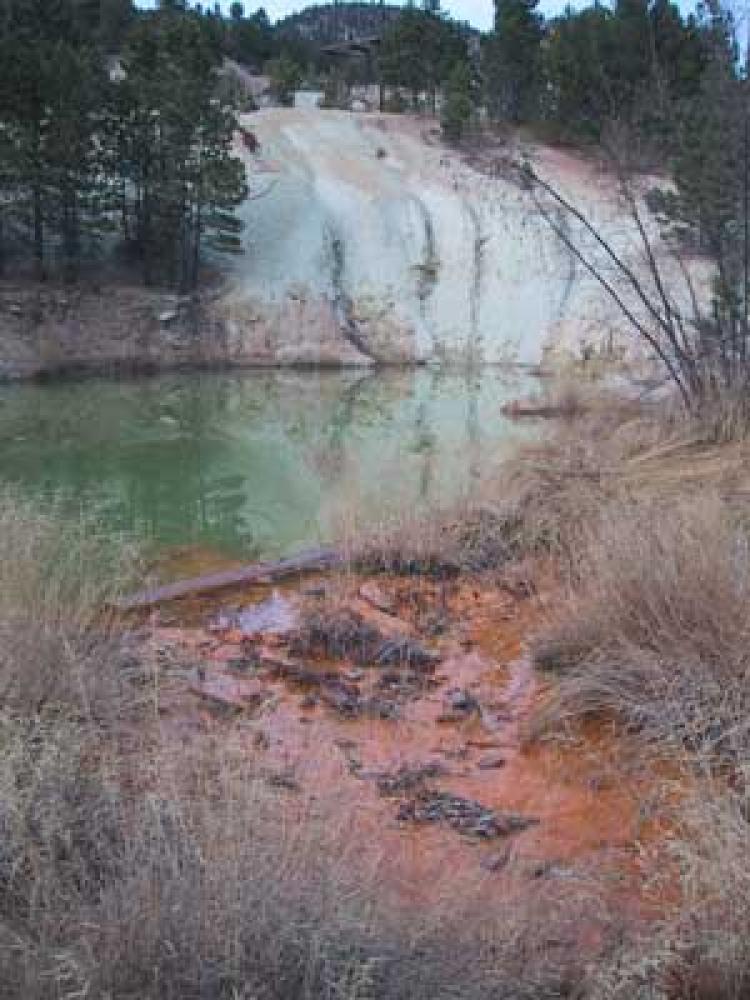
The acidic drainage from the subsidence pit pond at the Burlington Mine showing the characteristic ferric oxyhydroxide precipitation associated with the acid mine drainage.

